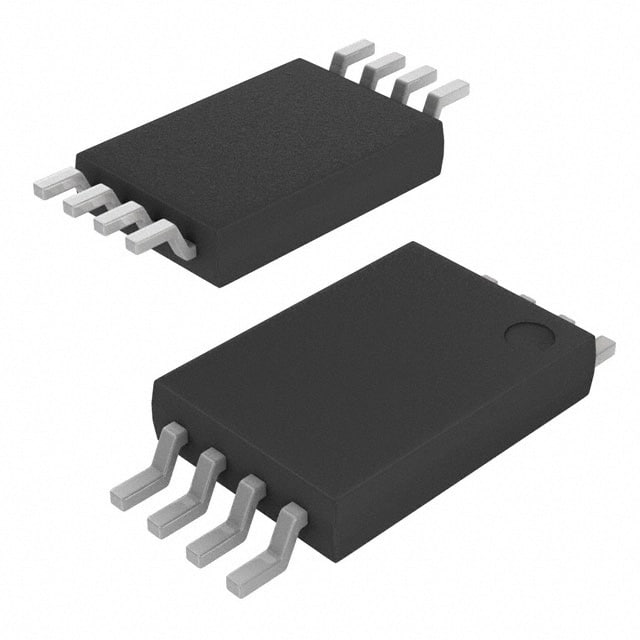Viz Specifikace pro podrobnosti o produktu.

MAX96711GTJ+ - English Editing Encyclopedia Entry
Product Overview
- Category: Integrated Circuit (IC)
- Use: Video Serializer
- Characteristics: High-speed, low-power, compact size
- Package: 32-pin TQFN
- Essence: Converts parallel video data to serialized format
- Packaging/Quantity: Tape and reel, 2500 units per reel
Specifications
- Supply Voltage: 1.8V to 3.6V
- Operating Temperature Range: -40°C to +85°C
- Data Rate: Up to 2.5 Gbps
- Number of Channels: 4
- Output Format: LVDS (Low-Voltage Differential Signaling)
- Input Format: Parallel RGB or YCbCr
- Control Interface: I2C
Detailed Pin Configuration
The MAX96711GTJ+ has a total of 32 pins. The pin configuration is as follows:
| Pin Number | Pin Name | Description | |------------|----------|-------------| | 1 | VCC | Power Supply Voltage | | 2 | GND | Ground | | 3 | SDA | I2C Serial Data Input | | 4 | SCL | I2C Serial Clock Input | | 5-8 | IN[0:3] | Parallel Video Data Inputs | | 9-12 | GND | Ground | | 13-16 | IN[4:7] | Parallel Video Data Inputs | | 17 | GND | Ground | | 18 | EN | Enable Input | | 19-22 | GND | Ground | | 23-26 | OUT[0:3] | LVDS Serialized Video Outputs | | 27-32 | GND | Ground |
Functional Features
- Converts parallel video data to serialized LVDS format
- Supports up to 4 channels of video data
- Low power consumption for energy-efficient applications
- High-speed data transmission up to 2.5 Gbps
- Compact size for space-constrained designs
- I2C control interface for easy configuration
Advantages and Disadvantages
Advantages: - Efficient conversion of parallel video data to serialized format - High-speed data transmission capability - Compact size allows for flexible integration in various applications - Low power consumption for energy-efficient operation
Disadvantages: - Limited to LVDS output format, may not be compatible with all systems - Requires external control interface (I2C) for configuration
Working Principles
The MAX96711GTJ+ is designed to convert parallel video data into a serialized format using LVDS signaling. It accepts parallel RGB or YCbCr video data inputs and converts them into four LVDS serialized video outputs. The IC operates on a supply voltage range of 1.8V to 3.6V and supports high-speed data transmission up to 2.5 Gbps. The control interface is implemented using the I2C protocol, allowing for easy configuration of the device.
Detailed Application Field Plans
The MAX96711GTJ+ finds applications in various fields where the conversion of parallel video data to a serialized format is required. Some potential application areas include: - Automotive infotainment systems - Surveillance cameras - Medical imaging devices - Industrial automation equipment - Consumer electronics
Detailed and Complete Alternative Models
- MAX96705GTJ+: Similar functionality, but with 5 channels instead of 4
- MAX96720GTJ+: Higher data rate support up to 3.12 Gbps
- MAX96730GTJ+: Supports 8 channels of video data
These alternative models offer similar features and can be considered based on specific application requirements.
Word count: 389 words
Seznam 10 běžných otázek a odpovědí souvisejících s aplikací MAX96711GTJ+ v technických řešeních
Sure! Here are 10 common questions and answers related to the application of MAX96711GTJ+ in technical solutions:
Q: What is the MAX96711GTJ+? A: The MAX96711GTJ+ is a high-speed serializer with LVDS (Low Voltage Differential Signaling) outputs, commonly used for transmitting video data over long distances.
Q: What are the key features of the MAX96711GTJ+? A: The key features include a maximum data rate of 3.12 Gbps, support for up to 4 lanes of LVDS output, programmable pre-emphasis and equalization, and low power consumption.
Q: How can I interface the MAX96711GTJ+ with my microcontroller or FPGA? A: The MAX96711GTJ+ uses a parallel interface for control and configuration. You can connect it to your microcontroller or FPGA using GPIO pins or a dedicated parallel bus.
Q: Can the MAX96711GTJ+ be used for transmitting audio signals as well? A: No, the MAX96711GTJ+ is specifically designed for video transmission. It does not support audio signals.
Q: What is the maximum cable length supported by the MAX96711GTJ+? A: The maximum cable length depends on various factors such as cable quality and data rate. However, with proper cable and signal conditioning, it can support cable lengths of up to several meters.
Q: Can I use the MAX96711GTJ+ in automotive applications? A: Yes, the MAX96711GTJ+ is suitable for automotive applications. It has a wide operating temperature range and supports EMI (Electromagnetic Interference) mitigation techniques.
Q: Does the MAX96711GTJ+ require external power supply decoupling capacitors? A: Yes, it is recommended to use external power supply decoupling capacitors for stable operation. The datasheet provides guidelines on the required capacitance and placement.
Q: Can I cascade multiple MAX96711GTJ+ devices for higher channel count? A: Yes, you can cascade multiple MAX96711GTJ+ devices to increase the number of LVDS output channels. Each device will require its own control interface and power supply.
Q: What are the typical applications of the MAX96711GTJ+? A: The MAX96711GTJ+ is commonly used in automotive infotainment systems, surveillance cameras, medical imaging equipment, and other applications requiring high-speed video transmission.
Q: Where can I find more information about the MAX96711GTJ+? A: You can find detailed information, including datasheets, application notes, and reference designs, on the manufacturer's website or by contacting their technical support team.
Please note that these answers are general and may vary depending on specific design requirements and implementation details. It is always recommended to refer to the official documentation and consult with technical experts for accurate and up-to-date information.

